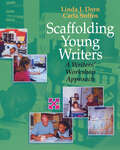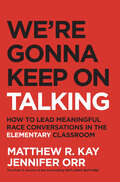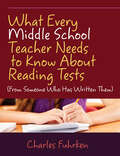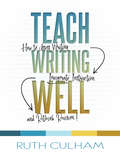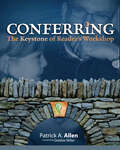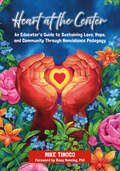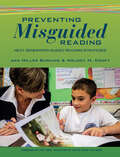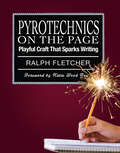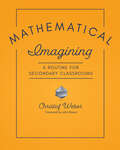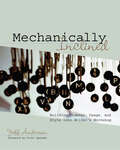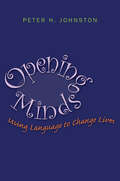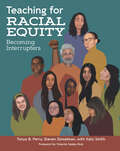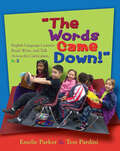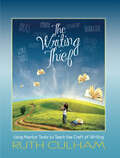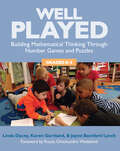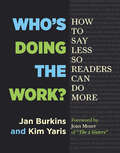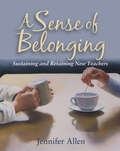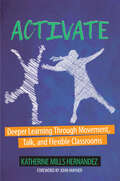- Table View
- List View
Scaffolding Young Writers: A Writer's Workshop Approach
by Linda Dorn Carla SoffosThe goal of teaching writing is to create independent and self-motivated writers. When students write more often, they become better at writing. They acquire habits, skills, and strategies that enable them to learn more about the craft of writing. Yet they require the guidance and support of a more knowledgeable person who understands the writing process, the changes over time in writing development, and specific techniques and procedures for teaching writing. In Scaffolding Young Writers: A Writers' Workshop Approach , Linda J. Dorn and Carla Soffos present a clear road map for implementing writers' workshop in the primary grades. Adopting an apprenticeship approach, the authors show how explicit teaching, good models, clear demonstrations, established routines, assisted teaching followed by independent practice, and self-regulated learning are all fundamental in establishing a successful writers' workshop. There is a detailed chapter on organizing for writers' workshop, including materials, components, routines, and procedures. Other chapters provide explicit guidelines for designing productive mini-lessons and student conferences. Scaffolding Young Writers also features: An overview of how children become writers; Analyses of students' samples according to informal and formal writing assessments Writing checklists, benchmark behaviors, and rubrics based on national standards Examples of teaching interactions during mini-lessons and writing conferences Illustrations of completed forms and checklists with detailed descriptions, and blank reproducible forms in the appendix for classroom use Instruction is linked with assessment throughout the book, so that all teaching interactions are grounded in what children already know and what they need to know as they develop into independent writers.
We're Gonna Keep On Talking: How to Lead Meaningful Race Conversations in the Elementary Classroom
by Jennifer Orr Matthew KayWhat should conversations about race look and sound like in the elementary classroom?How do we respond authentically and truthfully to children's questions about the world?And how can we build classroom communities that encourage these meaningful conversations about race?Matthew Kay and Jennifer Orr take on these questions and more in We're Gonna Keep On Talking: How to Lead Meaningful Race Conversations in the Elementary Classroom . A companion work to Kay's Not Light, But Fire , this book focuses on the unique and powerful role discussions about race can play in the elementary classroom.Drawing its title inspiration from the lyrics of the freedom song Ain't Gonna Let Nobody Turn Me Around,- sung by hundreds of children marching against segregation in what came to be known as the Children's Crusade of 1963, We're Gonna Keep On Talking is written for teachers who are willing to match children's courage and brilliance, and who believe that a foundation in meaningful race discourse will help [children] to seek justice for themselves and their neighbors, to be kinder, [and] more thoughtful.-Writing with the humility and honest storytelling of two career classroom teachers, Matthew Kay and Jennifer Orr share: Strategies for building safe and supportive classroom and school spaces for productive discourseDozens of practical teacher moves for facilitating race conversationsClassroom stories that allow readers to envision ways into the work through picture books, art, graphs, historical photographs, and current eventsTips for aligning the work of race conversations to your grade-level standardsWhether you are unsure of where to begin or looking to deepen your practice, We're Gonna Keep On Talking will be your guide to the important work of race conversations in the elementary classroom.
What Every Middle School Teacher Needs to Know About Reading Tests: (From Someone Who Has Written Them)
by Charles FuhrkenTests require a special kind of savvy, a kind of critical thinking and knowledge application that is not always a part of classroom reading experiences. Who better to teach you how to prepare your students for reading tests than someone who has written them? Charles Fuhrken has spent years working with several major testing companies and contributing to the reading assessments of various testing programs. What he' s learned about testing can help teachers who are interested in teaching effective reading strategies as well as preparing students for reading tests. What Every Middle School Teacher Needs to Know About Reading Tests (From Someone Who Has Written Them)' offers extensive, practical strategies to help students perform well on test day. This ready-to-use, easy-to-understand resource provides a wealth of information about reading tests, including high-quality preparation materials, samples of the most frequently assessed reading standards, and engaging core-reading activities. Charles takes the mystery out of reading tests; he explains how students can learn the language of tests and apply their knowledge of reading to standardized tests. In addition to providing information about reading tests that will help students feel prepared and confident on test day,' What Every Middle School Teacher Needs to Know About Reading Tests' provides a wealth of resources that can be incorporated into a teacher' s everyday reading work, including vocabulary development, literary techniques, interpretation, comprehension, and more.
Teach Writing Well: How to Assess Writing, Invigorate Instruction, and Rethink Revision
by Ruth CulhamAsk great writers what the key to writing well is and they will tell you revision. Author Ruth Culham, both a successful writer and writing teacher, understands the challenges elementary teachers face when teaching writing and revision and now shares her knowledge in Teach Writing Well: How to Assess Writing, Invigorate Instruction, and Rethink Revision. Divided into two parts, Culham&’s book provides ways to teach that are both accessible to the teacher and student. You will find techniques to assess writing that are practical, and results driven. Inside you&’ll discover: Culham&’s traits of writing and how to use them to read and assess student work Ways to guide revision decisions using these traits as common language How to address challenges students may face within the different modes of writing (narrative, expository, and persuasive) Strategic lessons to teach the writer that scaffold students towards making their own craft decisions A chapter on mentor texts which can be used to model traits and key qualities for your students Teach Writing Well pulls best practices together and shows writing with fresh eyes.
Conferring: The Keystone of Reader's Workshop
by Patrick AllenIn his years of teacher workshops, author Patrick Allen has heard it all: 'I don't have time! 'I don't know what questions to ask! 'I don't know what to write in my notes, it's too hard! In his book Conferring: The Keystone of Reader's Workshop, Allen argues that the benefits of conferring outweigh the challenges and that teachers must put forth the effort of learning how to do it well. Inside, he shows teachers how to overcome their perceived obstacles and shows them how they can make conferring tangible.' Conferring lays the groundwork for effective reading instruction. Conferences with students are purposeful conversations that scaffold reading comprehension strategies to guide the reader's progress. Ultimately, through the gradual release of responsibility, you will create engaged and independent readers. Starting with what conferring isn't, Allen unpacks the essential components of the process: Intimacy: the social context of conferring Rigor: the cognitive context of conferring Inquiry: the analytical context of conferring' With his guidance, you will be able to set goals for student conferring and elevate student reader conferences from start to finish.
Heart at the Center: An Educator's Guide to Sustaining Love, Hope, and Community Through Nonviolence Pedagogy
by Mike TinocoIn Heart at the Center: An Educator’s Guide to Sustaining Love, Hope, and Community Through Nonviolence Pedagogy, high school teacher Mike Tinoco examines what it means to reimagine classrooms and schools as spaces that humanize, resist violence and injustice, and center love.Offering both a framework and a set of practices that are grounded in different nonviolence traditions, Heart at the Center asks readers to consider what a pedagogy of nonviolence looks like, sounds like, and feels like in the classroom.Written with warmth, expertise, and humility, Mike Tinoco invites us into his classroom, drawing on stories from his own life and powerful examples from civil rights movement leaders to explore questions such as: How do we create classrooms and schools that are grounded in needs and match our vision for the kind of world we dream of? How can we challenge conventional classroom management practices, welcome conflict, and nurture relationships with and amongst our students to foster positive peace? How can we embed love in our curriculum and be inclusive of our students’ lives, centering community, healing, and justice? How can we slow down and take care of ourselves without compromising the urgency to fight for justice? When can voluntary suffering meet our needs and empower us? How can educators navigate conflict, build community with one another, and create their own professional development opportunities that support collective care? Heart at the Center is a book for educators who believe that a different kind of classroom, a different kind of school, and a different kind of world are possible.
Preventing Misguided Reading: Next Generation Guided Reading Strategies
by Jan Burkins Melody M. CroftWith over 50 years of collective reading experience, authors Jan Burkins and Melody Croft bring their expertise to Preventing Misguided Reading: Next Generation Guided Reading Strategies . The authors present personal clarifications, adaptations, and supports that have helped them work through the tricky parts as they guide readers in the classroom. Inside, each of the six chapters clarifies a misunderstanding about guided reading instruction in the following areas: Teacher's Role and Gradual Release of Responsibility Instructional Reading Level Text Gradients Balanced Instruction Integrated Processing Assessment With 27 strategies, Burkins and Croft will help you reframe your way of thinking about teaching reading and act on "revisioning" strategically.
Pyrotechnics on the Page: Playful Craft That Sparks Writing
by Ralph FletcherChildren have a natural affinity for language play; Pyrotechnics on the Page demonstrates how writing teachers can tap into it. This book provides a wealth of resources for teachers, including information on the roots and developmental importance of language play, a how-to on using the writer's notebook as a playground for students to explore and experiment with verbal pyrotechnics, an in-depth look at the kind of language play commonly used by writers, twenty-four brand new craft lessons to bring pyrotechnics into the classroom, and an extensive bibliography of relevant mentor texts. Pyrotechnics on the Page is vintage Fletcher: personal, anecdotal, and practical.
Mathematical Imagining: A Routine for Secondary Classrooms
by Christof WeberImagine a plastic cup lying on the floor. Give the cup a nudge so that it begins to roll. What does the path it takes look like? So begins the journey that Christof Weber takes you on in Mathematical Imagining: A Routine for Secondary Classrooms . Along the way, he makes the case that the ability to imagine, manipulate, and explain mathematical images and situations is fundamental to all mathematics and particularly important to higher level study. Most importantly, drawing on years of experiments in his own classroom, Weber shows that mathematical imagining is a skill that can be taught efficiently and effectively. Mathematical Imagining describes an original routine that gives students space and time to imagine a mathematical situation and then revise, discuss, and act upon the mental images they create. You can use this creative routine to glimpse into your students' thinking and discover teaching opportunities, while empowering them to create their own mathematics.Inside you’ll find the following: An introduction to the routine including the rationale behind it, facilitation guidance, and classroom examples Modifications to implement the routine in your classroom, even with varying time constraints 37 exercises broken into four categories: constructions, problem-solving, reasoning, and paradoxes Discussions of the mathematics involved in each exercise, including possible follow-up questions Instructions on how to create your own exercises beyond the book This one-of-a-kind resource is for secondary teachers looking to inspire student creativity and curiosity, deepen their own subject matter knowledge and pedagogical content knowledge, and invite all students to access the power of their own mathematical imaginations.
Mechanically Inclined: Building Grammar, Usage, and Style into Writer's Workshop
by Jeff AndersonSome teachers love grammar and some hate it, but nearly all struggle to find ways of making the mechanics of English meaningful to kids. As a middle school teacher, Jeff Anderson also discovered that his students were not grasping the basics, and that it was preventing them from reaching their potential as writers. Jeff readily admits, “I am not a grammarian, nor am I punctilious about anything,” so he began researching and testing the ideas of scores of grammar experts in his classroom, gradually finding successful ways of integrating grammar instruction into writer's workshop. Mechanically Inclined is the culmination of years of experimentation that merges the best of writer's workshop elements with relevant theory about how and why skills should be taught. It connects theory about using grammar in context with practical instructional strategies, explains why kids often don't understand or apply grammar and mechanics correctly, focuses on attending to the “high payoff,” or most common errors in student writing, and shows how to carefully construct a workshop environment that can best support grammar and mechanics concepts. Jeff emphasizes four key elements in his teaching:short daily instruction in grammar and mechanics within writer's workshop;using high-quality mentor texts to teach grammar and mechanics in context;visual scaffolds, including wall charts, and visual cues that can be pasted into writer's notebooks;regular, short routines, like “express-lane edits,” that help students spot and correct errors automatically.Comprising an overview of the research-based context for grammar instruction, a series of over thirty detailed lessons, and an appendix of helpful forms and instructional tools, Mechanically Inclined is a boon to teachers regardless of their level of grammar-phobia. It shifts the negative, rule-plagued emphasis of much grammar instruction into one which celebrates the power and beauty these tools have in shaping all forms of writing.
Opening Minds: Using Language to Change Lives
by Peter JohnstonIntroducing a spelling test to a student by saying, 'Let' s see how many words you know,' is different from saying, 'Let's see how many words you know already.' It is only one word, but the already suggests that any words the child knows are ahead of expectation and, most important, that there is nothing permanent about what is known and not known. Peter Johnston Grounded in research, Opening Minds: Using Language to Change Livesshows how words can shape students' learning, their sense of self, and their social, emotional and moral development. Make no mistake: words have the power to open minds – or close them. Following up his groundbreaking book, Choice Words, author Peter Johnston continues to demonstrate how the things teachers say (and don't say) have surprising consequences for the literate lives of students. In this new book, Johnston shows how the words teachers choose can affect the worlds students inhabit in the classroom. He explains how to engage children with more productive talk and how to create classrooms that support students' intellectual development, as well as their development as human beings.
Teaching for Racial Equity: Becoming Interrupters
by Steven Zemelman Tonya B. Perry Katy SmithRecipient of the 2022 Excellence in Equity Award! It is not enough to be against racism in education teachers must be actively antiracist. Yet how do we start reflecting on our own beliefs and lives so we can truly teach for racial literacy? In the award-winning Teaching for Racial Equity: Becoming Interrupters , authors Tonya Perry, Steven Zemelman, and Katy Smith engage in honest conversations between educators of color and their white colleagues. Authentic, inspiring, and sometimes uncomfortable, teachers share stories of personal histories and experiences that shaped them as people and educators.In this book you will find: Strategies to understand different backgrounds through a racial lens and ways to address potentially difficult conversations with fellow educators In-depth overview of Yolanda Sealey-Ruiz&’s Archaeology of Self™ and how it can be personally and professionally adopted Lists of resources for teaching about and actively interrupting racism in education and tools that document systemic inequalities in the classroom Ways to facilitate student-led conversations which examine race and inequitable conditions found nationwide By examining inequalities found at a systemic level, teachers can start to remove some of their internal biases and allow students to show who they truly are. In turn, this can help create a school curriculum that makes space for BIPOC voices that inspire and invite students to share. Teaching for Racial Equity: Becoming Interrupters provides a resource for teachers and educators to critically reflect and begin work to interrupt racism at all levels.
Words Came Down!: English Language Learners Read, Write, and Talk Across the Curriculum, K-2
by Emelie Parker Tess PardiniAs teachers everywhere find more and more students with limited English in their classes, many are asking: How can I include ELL students in every aspect of the day? The Words Came Down!: English Language Learners Read, Write, and Talk Across the Curriculum, K-2 oral language is emphasized in a continuum from teacher modeling and demonstration to situations in which student-to-student communication is essential. The authors show that when children's attempts at communicating are accepted and celebrated, they will learn to communicate with each other comfortably and spontaneously whether on the playground or working on a science experiment. Beginning with designing a classroom that welcomes students and creates appropriate conditions for learning, Emelie Parker and Tess Pardini go on to detail a workshop format for reading, writing and content-area studies. The workshop structure allows teachers to differentiate instruction to include all students, and affords students ample opportunities to collaborate with others as they learn to speak, read, write, and comprehend while also engaging in active learning of the curriculum. The authors provide numerous examples of ways that teachers can become proficient in knowing each child and orchestrating instruction to meet individual needs. In addition, this helpful guide offers a variety of approaches to assessment, and demonstrates the importance of engaging families as partners in learning English and content.
Writing Thief: Using Mentor Texts to Teach the Craft of Writing
by Ruth CulhamMediocre writers borrow. Great writers steal. --T.S. EliotWriting thieves read widely, dive deeply into texts, and steal bits and pieces from great texts as models for their own writing. Author Ruth Culham admits to being a writing thief'sand she wants you and your students to become writing thieves, too! In The Writing Thief: Using Mentor Texts to Teach the Craft of Writing, Culham demonstrates a major part of good writing instruction is finding the right mentor texts to share with students. Within this book, you'll discover more than 90 excellent mentor texts, along with straight-forward activities that incorporate the traits of writing across informational, narrative, and argument modes. Chapters also include brief essays from beloved writing thieves such as Lester Laminack, David L. Harrison, Lisa Yee, Nicola Davies, Ralph Fletcher, Toni Buzzeo, Lola Schaefer, and Kate Messner, detailing the reading that has influenced their own writing. Culham's renowned easy-going style and friendly tone make this a book you'll turn to again and again as you coach your students to reach their full potential as deep, thoughtful readers and great writers. There's a writing thief in each of us when we learn how to read with a writer's eye!
Well Played, Grades K-2: Building Mathematical Thinking Through Number Games and Puzzles
by Linda Dacey Karen Gartland Jayne Bamford LynchStudents love math games and puzzles, but how much are they really learning from the experience? Too often, math games are thought of as just a fun activity or enrichment opportunity. Well Played, Grades K-2: Building Mathematical Thinking Through Number Games and Puzzles, shows you how to make games and puzzles an integral learning component that provides teachers with unique access to student thinking. The twenty-five games and puzzles in Well Played, Grades K-2 , which have all been field-tested in diverse classrooms, contain: • Explanations of the mathematical importance of each game or puzzle and how it supports student learning • Variations for each game or puzzle to address a range of learning levels and styles • Classroom vignettes that model how best to introduce the featured game or puzzle The book also includes a separate chapter with suggestions for how to effectively manage games and puzzles in diverse classrooms;game boards, game cards, and puzzles; assessment ideas; and suggestions for online games, puzzles, and apps. Well Played, Grades K-2 will help you tap the power of games and puzzles to engage students in sustained and productive mathematical thinking.
Who's Doing the Work?: How to Say Less So Readers Can Do More
by Jan Burkins Kim YarisBest-selling authors Dr. Jan Burkins and Kim Yaris rethink traditional teaching practices Who's Doing the Work: How to Say Less So Readers Can Do More. They review some common instructional mainstays such as read-aloud, guided reading, shared reading, and independent reading and provide small, yet powerful, adjustments to help hold students accountable for their learning.Next generation reading instruction is much more responsive to student needs and aims to remove some of the scaffolding that can hinder reader development. Instead of relying on teacher prompts, Who's Doing the Work asks teachers to have students take ownership of their reading by managing their challenges independently and working through any plateaus they encounter. Whether you are an elementary teacher, literacy coach, reading specialist, or parent, Who's Doing the Work provides numerous examples on how to readjust the reading process and teach students to gain proficiency and joy in their work.
A Sense of Belonging: Sustaining and Retaining New Teachers
by Jennifer AllenToo often, new teachers enter the profession excited to make a difference in the lives of children only to find themselves disillusioned and overwhelmed with the expectations of the classroom. In A Sense of Belonging, Jennifer Allen shares her stories and journey in creating an infrastructure of support for new teachers within her school district. A Sense of Belonging provides research-based, practical ideas on how to support new teachers while honoring the innovation, idealism, and optimistic enthusiasm that they bring to the classroom. From supporting new teachers early in the year with administering and analyzing literacy assessments, through using student work to guide instruction, to offering ongoing help with curriculum planning, Jennifer shares strategies on:, fostering relationships with new teachers, starting before school even begins;, creating learning environments for new teachers to be reflective practitioners;, coaching new teachers in their classrooms and providing opportunities for them to observe their peers in action;, supporting new teachers beyond their first year through gradual release of support over their first several years in the classroom; and, facilitating professional development opportunities where new and veteran teachers learn alongside one another. Jennifer believes, and her book demonstrates, that when schools embrace, encourage, and celebrate the work of new teachers, they establish a supportive environment that fosters excellence and improves retention.
Activate: Deeper Learning through Movement, Talk, and Flexible Classrooms
by Katherine HernandezDiscover what happens when your students step out of their daily routines and activate their engagement. Author Katherine Mills Hernandez argues that movement, talk, and the physical environment of the classroom all contribute and influence students' learning. The ideas in Activate! will help you create a classroom optimized for deeper engagement and lasting learning.No matter what subject you teach, Katherine invites you to shift your attention from what you are doing in the classroom, to what your students are doing as the catalyst for learning. She provides insights into instruction through real classroom lessons as she gives you the tools to better assess your students' engagement and energy levels. The book describes practical ways to incorporate movement into the classroom routine, based on research on how an active brain generates true learning.Katherine invites you into her own classroom by sharing vignettes from lessons and activities, opening up the pages of her own learning journal, sharing pictures from her classroom, and examples of classroom charts. She also provides a comprehensive bibliography on the research behind the science of movement and talk and how they affect learning.
Black Ants and Buddhists: Thinking Critically and Teaching Differently in the Primary Grades
by Mary CowheyWhat would a classroom look like if understanding and respecting differences in race, culture, beliefs, and opinions were at its heart? If you were inspired to become a teacher because you wanted to develop young minds, but now find yourself limited by "teach to the test" pressures and state standards, Mary Cowhey's book Black Ants and Buddhists: Thinking Critically and Teaching Differently in the Primary Grades will reignite the passion and remind you that educators provide more than test prep. Starting her career as a community activist, Cowhey shares her roots and how they influenced her Peace Class, where she asks her students to think critically, learn through activism and discussion, and view the entire curriculum through the framework of understanding the world, and what they can do to make it a better place. Woven through the book is Mary's unflinching and humorous account of her own roots as well as lessons from her heroes: Gandhi, Eleanor Roosevelt, Helen Keller, Martin Luther King, Jr, and others. Her students learn to make connections between their lives, the books they read, the community leaders they meet, and the larger world. Black Ants and Buddhists offers no easy answers, but it does include starting points for conversations about diversity and controversy in your classroom, as well as in the larger community. Students and teachers investigate problems and issues together, in a multicultural, antiracist classroom.
Day by Day: Refining Writing Workshop Through 180 Days of Reflective Practice
by Stacey Shubitz Ruth AyresHave you ever wanted your own personal writing coach to help improve your teaching of writing? How about two personal writing coaches? In Day by Day, Stacey Shubitz and Ruth Ayres, creators of the popular blog Two Writing Teachers, guide you through the trials and tribulations of a whole year of writing workshop. ' Day by Day is organized around six fundamental components of writing workshoproutines, mini-lessons, choice, mentors, conferring, and assessment. Each component is broken down into ten-day sections. Each section includes a detailed discussion, a challenge that teachers can apply immediately,' and questions to help teachers assess the process to see what went right, what went wrong, and, most importantly, why.' Ruth and Stacey also provide daily encouragement, support, practical strategies, tips, advice, and everything you need to run an effective writing workshop that meets the needs of all the different writers in your classroom.
Story: Still the Heart of Literacy Learning
by Katie CunninghamStories are all around us. From our digital newsfeeds, interactions with one another, to watching a movie or listening to a curated playlist, we see and hear different tales told to us in various ways.In her book, Story: Still the Heart of Literacy Learning, author and teacher Katie Egan Cunningham reminds us that when we bridge reading strategies with the power of story, we can deepen literacy learning and foster authentic engagement with students. Cunningham shows how to create classrooms of caring and inquisitive readers, writers, and storytellers. Inside you'll find: How to build a diverse, multicultural classroom library that reflects all voices through rich, purposeful, and varied textsNumerous examples of multi-genre and multi-modal stories from children's and young adult literatureA practical toolkit at the end of each chapter to demonstrate how to make stories come alive in any classroom Throughout the book, Cunningham shares her experiences as a teacher, literacy specialist, and staff developer and how building and talking about stories brings them to life. She honors the importance of teaching strategies to read different kinds of text, to write across genres, and to speak and listen with purpose while reminding us about the importance of story.
Reality Checks: Teaching Reading Comprehension with Nonfiction, K-5 (Tony Stead Content Area Collection Ser.)
by Tony SteadTeaching comprehension with informational texts is a critical component of any reading program and one that many children struggle with as they progress through their schooling. Nonfiction can be overwhelming to young readers, presenting them with complex vocabulary and a new density of information that may combine text, diagrams, pictures, captions, and other devices.Reality Checks: Teaching Reading Comprehension with Non-Fiction K-5 offers insights into why children struggle when faced with informational reading, and practical concepts, skills, and strategies that help them navigate nonfiction successfully.In this book, Tony Stead provides wonderful ways to enhance children's understanding and engagement when reading for information. He outlines practical approaches to ensure all children can become confident and competent readers of nonfiction. Part one examines effective ways to teach children how to extract the information that is explicitly stated in a text. Covered are strategies such as using prior knowledge, retelling, locating specific information, and the role of nonfiction read-alouds. Part two explores interpreting information, including making connections between the text, the reader, and the outside world, making inferences and making revisions to inferences based on reflection. Part three looks at evaluating information, assisting children in developing critical reading skills, differentiating fact from opinion, locating author bias, and identifying techniques writers use to persuade readers' thinking. Part four offers an array of practical ways to reinforce and extend children's nonfiction reading skills, including working with visual information such as maps and diagrams. It also provides pre-and -post-assessment strategies, procedures for monitoring progress, curriculum planning ideas, and instruction on guided reading.
Revision Decisions: Talking Through Sentences and Beyond
by Jeff Anderson Deborah DeanRevision is often a confusing and difficult process for students, but it's also the most important part of the writing process. If students leave our classrooms not knowing how to move a piece of writing forward, we've failed them. Revision Decisions: Talking Through Sentences and Beyond will help teachers develop the skills students need in an ever-evolving writing, language, and reading world. Jeff Anderson and Deborah Dean have written a book that engages writers in the tinkering, playing, and thinking that are essential to clarify and elevate writing. Focusing on sentences, the authors use mentor texts to show the myriad possibilities that exist for revision. Essential to their process is the concept of classroom talk. Readers will be shown how revision lessons can be discussed in a generative way, and how each student can benefit from talking through the revision process as a group. Revision Decisions focuses on developing both the writing and the writer. The easy-to-follow lessons make clear and accessible the rigorous thinking and the challenging process of making writing work. Narratives, setup lessons, templates, and details about how to move students toward independence round out this essential book. Additionally, the authors weave the language, reading, and writing goals of the Common Core and other standards into an integrated and connected practice. The noted language arts teacher James Britton once said that good writing floats on a sea of talk. Revision Decisions supports those genuine conversations we naturally have as readers and writers, leading the way to the essential goal of making meaning.
Teaching with Intention: Defining Beliefs, Aligning Practice, Taking Action, K-5
by Debbie MillerEffective, intentional teaching begins with a strong set of beliefs, but even the best teachers -- including author Debbie Miller -- struggle to make sure that their classroom practice consistently reflects their core convictions. In Teaching with Intention: Defining Beliefs, Aligning Practice, Taking Action, K-5, Miller defines her actions to ensure that children are the true beneficiaries of her teaching. As Peter Johnston writes, Through this book we have Debbie's teaching mind on loan. She engages us in the details of a teaching life from inside her mind, showing the thinking behind her teaching and the consequences of her actions.Teaching with Intention brings us into classrooms of teachers and children Miller has met over the last five years in her work as a literacy consultant. From setting up the classroom environment to the intentional use of language, from comprehension instruction to lesson design, Miller is explicit about what she does and why. At the same time, she encourages teachers to develop their own belief statements concerning teaching and learning and includes key questions to guide them in this important process.In an environment where the handing down of scripted programs and foolproof curricula is increasingly the norm, Teaching with Intention offers a compelling reminder that truly transformative teaching is built from the ground up, and is rebuilt every year, by every teacher, in every classroom, with every new group of students.
TeamWork: Setting the Standard for Collaborative Teaching, Grades 5-9
by Monique Wild Amanda Mayeaux Kathryn EdmondsTeamWork: Setting the Standard for Collaborative Teaching, Grades 5–9is full of captivating stories and insightful conversations. The teamers provide an honest and richly detailed explanation of collaborative teaching in action. They deliver the straight scoop on teaming, offering insights on these and other key topics: How to shape a shared purpose for learning by mining the talents of students and colleagues How to build strong partnerships with parents, principals, and other key people who influence the lives of young adolescents How to deepen curriculum integration by cutting the fluff.This insider' s guide to teaming reveals the conversations, the conflicts, and the collegial sharing that enables teachers to collaborate so that every member of the team can meet the highest standards of professional practice. For new teachers and seasoned veterans alike, TeamWork provides a powerful foundation for achievement.
